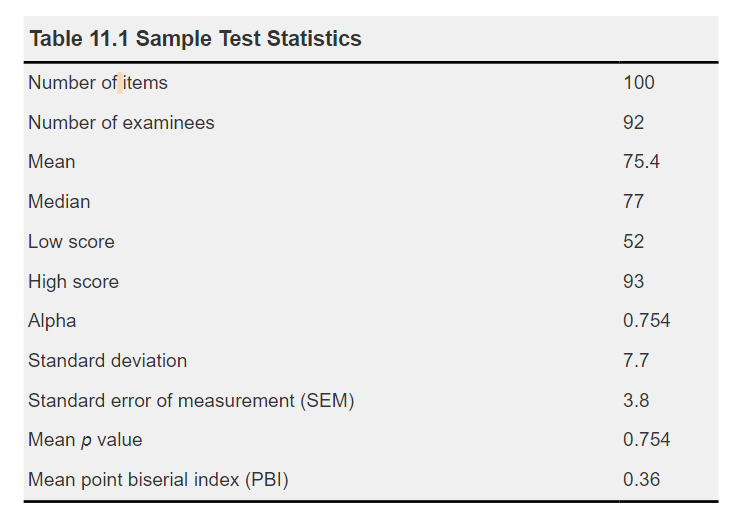Interpreting Test Results
“Statistics is the science of deriving uncertain facts from dependable figures.” — Evan Escar
The process of test development extends beyond test administration, encompassing post hoc test analysis as a critical phase. One of the advantages of selected-response exams lies in the ability to generate item and test analysis data from test results, particularly in the case of multiple-choice questions. These data reports offer valuable insights for fair scoring and the enhancement of individual items for future use. Test analysis serves three primary objectives: identifying flawed questions, correcting errors and adjusting raw scores, and refining items for future assessments.

Struggling to meet your deadline?
Get your assignment on Interpreting Test Results done by certified MDs and PhDs in the USA. ORDER NOW!
Qualitative and quantitative test reviews complement each other and are equally essential. Statistical data provide a more objective perspective when evaluating test items. Even when following test development guidelines, approximately 10% of new test items often yield unexpected results. Sometimes, student responses to well-constructed questions remain unpredictable.
Consider the time invested in item creation and refinement as an investment. Multiple-choice items can be analyzed, revised, and stored for future use. Over time, these items can be honed and adapted for use in upcoming tests. Continuous refinement of items based on data analysis enhances the quality of tests. Qualitative student reviews, as discussed in Chapter 9, “Assembling, Administering, and Scoring a Test,” often explain the statistical outcomes of an item and offer suggestions for improvement in future use. Evaluating quantitative data not only facilitates objective decisions about individual test items and overall test scores but also guides efficient use of time in improving questions and building a valuable testing resource: an item bank. The more items analyzed, the more proficient one becomes at crafting and identifying high-quality test items that can be stored and reused. Therefore, the time invested in this process is well worthwhile.
Before the advent of affordable testing software, calculating the statistical outcomes of an exam was impractical for educators. Nowadays, many institutions offer machine scoring with statistical reports and item analyses for multiple-choice classroom exams. This chapter aims to illustrate the immense value of these data reports as tools for test interpretation and development. Without statistical analysis, there is no assurance that tests are functioning as intended.
Overall Test Data Analysis
Most test development software packages provide two levels of test analysis data: an overall test analysis and a detailed analysis of each item in relation to the test as a whole. While the broader perspective should be the initial focus, both sets of data are crucial for comprehensive test analysis. It is essential to understand the meaning of each value, but actual calculations are unnecessary. Once these data are utilized, their value becomes evident, and you will never again assign grades to a multiple-choice exam without reviewing the statistical analysis.
After scoring a test, the initial result is a raw score, indicating the number of correct answers. Statistical analysis aids in transforming raw scores into test grades. Appendix B, “Basic Test Statistics,” provides an overview of statistical analysis terminology. Familiarizing yourself with basic statistical references before examining the sample statistical test report in Table 11.1 is recommended.

Table 11.1 presents a sample test analysis report, including typical data generated by testing software. In fact, this report offers ample data to make informed decisions about test results. Some programs provide even more comprehensive statistics. However, it is unnecessary to overly complicate the review; this sample data report is sufficient for classroom test analysis.
Fatima Khan Endocrine System Hourly Rounds Shadow health Objective data
Typically, item statistics are less stable for small student groups, gaining stability as the number of test takers approaches 100. Thus, with very small groups (50 or fewer), the relative instability of the data should be considered during interpretation. Test and item analysis should not be interpreted dogmatically, regardless of the number of students. This discussion demonstrates that test data analysis requires various interpretations, both qualitative and quantitative, and sample size is one of the factors to consider.
The initial step in test analysis is to ensure the completeness of the data report. Verify the number of items and examinees for accuracy. In this sample, there are 100 items, equating raw scores to percentages correct, and 92 examinees had their answer sheets scored. Once these figures are confirmed, you can proceed to analyze the test results.
Measures of Central Tendency
Measures of central tendency offer a single value that represents the typical score in a distribution. In education, the mean, median, and mode are the three commonly used measures of central tendency. While the mode represents the most frequently obtained score in a distribution, its utility for interpreting classroom test scores is limited. Both the mean and median, however, provide valuable insights.
Measures of Variability
Relying solely on measures of central tendency is insufficient for predicting score ranges, as two sets of scores with the same mean can exhibit vastly different score spreads. Measures of variability are essential to understand how scores deviate from the mean and the level of dispersion in a distribution.

Dont wait until the last minute.
Provide your requirements and let our native nursing writers deliver your assignments ASAP.